On Thanksgiving morning, I was making kimchi.
Turkey with all the trimmings wouldn’t be on today’s menu, as I was helping cook for a group of hungry senior citizens in Busan, South Korea. Correction: there was no turkey. However, since Korean cuisine is famous for the abundance of side dishes that accompany every meal, we were serving up plenty of “trimmings,” including several varieties of kimchi, what’s sometimes called “Korean ketchup.”
I’d come to South Korea to assist Shon Gyu-Ho, a man who ten years ago, founded an organization called Busan Baffer, which now feeds an estimated 3,000 people a day. Mr. Shon wears his long black hair pulled back in a ponytail, and his calm, scholarly demeanor is underscored by his customary attire, which is a collar-less Mandarin jacket. In addition to feeding the body, Mr. Shon believes his organization must also help heal minds.
“The reason homeless people have trouble interacting with society is they think they are weak,” he said. “We try to help people know that they can do something with their lives, and they can get a job.”
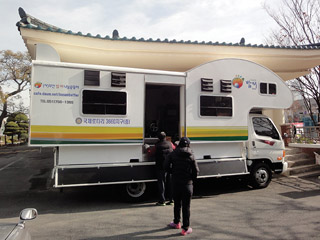 We were standing together on this November morning of 2012 beside a truck which was retrofitted to act as a mobile kitchen. Inside, were cookers in which vats of rice could be steamed, and a stainless steel cauldron where enormous quantities of soup simmer. Parked next to the mobile kitchen was a van holding a battered collection of folding card tables, and stackable plastic stools. Because the weather was sunny and clear, these would soon be arranged on a cobble-stoned plaza outside a Korail train station in Hae-undae. This is one of the wealthier neighborhoods of Busan, which is a coastal city, nearly at the Korean peninsula’s southernmost tip.
We were standing together on this November morning of 2012 beside a truck which was retrofitted to act as a mobile kitchen. Inside, were cookers in which vats of rice could be steamed, and a stainless steel cauldron where enormous quantities of soup simmer. Parked next to the mobile kitchen was a van holding a battered collection of folding card tables, and stackable plastic stools. Because the weather was sunny and clear, these would soon be arranged on a cobble-stoned plaza outside a Korail train station in Hae-undae. This is one of the wealthier neighborhoods of Busan, which is a coastal city, nearly at the Korean peninsula’s southernmost tip.
Hae-undae is known for its clusters of high-rise apartment buidings, as well as luxury hotels, the grandest of which is the Paradise Casino. (Posters for this casino are plastered up all over Busan, and show a photograph of the American movie star, Robert DeNiro, shuffling a deck of cards, and looking miserable while doing so.) If not quite a paradise for Busan’s poor, Hae-undae is at least something of an oasis. Those who are hungry come to this neighborhood to beg from wealthy tourists, paw about in dumpsters, or sit alone on concrete walls by the beach, staring out towards the South China Sea. They’ll also make their way to the Korail station, to get a free lunch from Mr. Shon and Busan Baffer.
“We try to help people know that they can do something with their lives, and they can get a job.”
The organization’s name loses something in the translation, but its meaning goes something like this. No Korean meal is complete without rice, and every Korean kitchen has an electric rice cooker. These are accessorized with a special spoon (made of bamboo, or plastic) that hangs on the cooker’s side. Koreans prefer a short grain rice, which clumps together as it absorbs moisture, and is dished out in big blobs, nearly like a generous scoop of ice-cream. Both the action of serving rice, and this special spoon are called a “baffer.” As such, for Koreans the word connotes abundance, similar to “smorgasbord” for Swedes, or a “cornucopia” for English-speakers.
I’d first met Mr. Shon, earlier that morning at the Busan Baffer headquarters.
Along with a dozen or so other men, he was sitting on the floor, at a low table, eating his breakfast of grilled fish and kimchi. It was barely 8:00 a.m., yet these men had already been working for several hours, loading up the mobile kitchen with rice and ingredients for today’s soup.
 The room in which they huddled is quite cold. At first, I can’t figure out why all the men appeared comfortable in shirt sleeves and T-shirts. When I sit down next to Mr. Shon, though, I discover the room’s only heat is coming from an electrified plastic mat, which in most Korean homes replaces carpeting. I realize I’ve seen these mats touted on television by hilarious advertisements in which, thanks to computer-generated imagery, flames of heat rise up from the floor, as we see grandma settle down on her floor mat for a nap, or a naked baby roll around in toasty-warm bliss. I found sitting on one to be an odd sensation; my shoulders shivered, but my testicles were getting fried.
The room in which they huddled is quite cold. At first, I can’t figure out why all the men appeared comfortable in shirt sleeves and T-shirts. When I sit down next to Mr. Shon, though, I discover the room’s only heat is coming from an electrified plastic mat, which in most Korean homes replaces carpeting. I realize I’ve seen these mats touted on television by hilarious advertisements in which, thanks to computer-generated imagery, flames of heat rise up from the floor, as we see grandma settle down on her floor mat for a nap, or a naked baby roll around in toasty-warm bliss. I found sitting on one to be an odd sensation; my shoulders shivered, but my testicles were getting fried.
Mr. Shon offered me a cup of very sweet instant coffee, which I sipped while we chatted.
Noting that the weather was starting to get colder, he said Busan Baffer was gearing up for its head counts to increase markedly in the months ahead. Similar to “snowbirds” in the United States, or those elderly folks who decamp from their houses up north, to the warmth of Florida for the winter, there is a similar migration of homeless men and women to Busan.
“Their children have all moved away, and
forgotten them.”
“It is much colder in Seoul, than it is here,” he explained. “So, starting at the end of November, poor people, usually men, will get onto trains headed south. They don’t have tickets, but the railroad conductors know these homeless passengers will make a scene if they try to evict them. So, they ride for free.”
This annual migration provides an eerie echo to how Busan was first populated. During the Korean War, (which Koreans, of course, call their Civil War) in the early 1950’s, Seoul was relentlessly pummeled with bombs. Refugees, by the tens of thousands, abandoned South Korea’s capitol, and fled to Busan. Most of them settled very close to the water’s edge, in hovels around the city’s main port. Busan was South Korea’s only major city which never fell to Communist rule, a fact that the city’s citizens still take pride in.
One hears much of the economic “miracle” that is South Korea. Today, it is the seventh-largest exporter in the world, and one of the most wired societies on the planet. During the spectacular recovery South Korea made in the Civil War’s aftermath, many parents focussed obsessively on their children’s educational and professional success, expecting their offspring’s future affluence to cushion them. So strong was the Confucian ideal of “filial piety,” or the unquestioned respect a child should show a parent, that the family was considered one’s only source of social security. Indeed, South Korea neglected to create any sort of national pension system until 1988.
Things didn’t work out as planned, however. As the post-war shift from an agrarian to an industrial society scattered a younger generation to cities, or abroad, these children began to face problems of their own — especially during the Asian financial crisis of the late 1990’s — making them less willing, or able, to care for their aged parents.
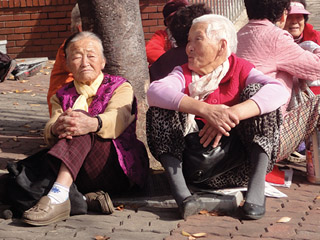 Today, South Korea’s suicide rate is among the highest in the world, according to statistics released by the OECD (Organization for Economic Cooperation and Development.) Measured by suicides per 100,000 people, South Korea’s numbers rose from 13.6 in 2001, to 31.2 in 2010. Among those who are 65 and older, most disturbingly, the rate ballooned from 35.5 to 81.9. What these figures show is the end of South Korea’s traditional Confucian social contract. The result is that elderly people make up the vast majority of those who eat meals provided by Busan Baffer.
Today, South Korea’s suicide rate is among the highest in the world, according to statistics released by the OECD (Organization for Economic Cooperation and Development.) Measured by suicides per 100,000 people, South Korea’s numbers rose from 13.6 in 2001, to 31.2 in 2010. Among those who are 65 and older, most disturbingly, the rate ballooned from 35.5 to 81.9. What these figures show is the end of South Korea’s traditional Confucian social contract. The result is that elderly people make up the vast majority of those who eat meals provided by Busan Baffer.
“Their children have all moved away, and forgotten them,” Mr. Shon said.
When he was a child, Mr. Shon told me, he lived next door to an orphanage for disabled children. These boys and girls became his friends, and he grew up with them. At age 18, however, these children would be declared “independent,” and summarily ejected from the orphanage and put out onto the street.
“A lot of them could not adjust to society. Several of my friends committed suicide,” he recalls. “This stuck with me, even as I started my career, and began to raise my family. I kept thinking that I have to do something for these poor people. Human beings have a right to eat, to be clothed, and to have a roof over their heads.”
For many years, Mr. Shon taught computer skills to elementary school students in the fourth through six grades. All the while, he schemed and dreamed, and finally figured out a system of two trucks that drive, as a tag-team, into Busan’s humblest neighborhoods and deliver hot meals.
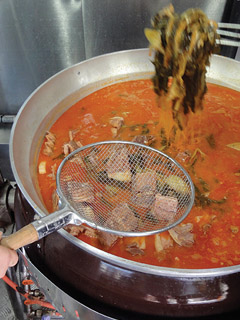 While Busan Baffer now looks to be a well-oiled machine, getting it operational was not easy for Mr. Shon. As described above, he was butting up against Confucian values which held that the family was to take care of all problems; Mr. Shon’s efforts were viewed as meddling and intrusive. Yet, as the scourge of senior citizen homelessness and hunger in South Korea grew to point where it could no longer be ignored, donations and volunteers began to come
While Busan Baffer now looks to be a well-oiled machine, getting it operational was not easy for Mr. Shon. As described above, he was butting up against Confucian values which held that the family was to take care of all problems; Mr. Shon’s efforts were viewed as meddling and intrusive. Yet, as the scourge of senior citizen homelessness and hunger in South Korea grew to point where it could no longer be ignored, donations and volunteers began to come
his way.
In the days I spent working alongside Mr. Shon, I helped prepare huge piles of Baechu. This is probably South Korea’s most popular form of kimchi, and made by combining Napa cabbage, garlic, ginger, salt and red pepper flakes, after which the mixture can be stored for months. Even when you wear rubber gloves while making Baechu, I discovered, the chile pepper somehow works its way through the plastic, and burns the flesh around your fingernails. It’s a slowly escalating form of torture.
Try that with a woman in New York City —
“Hey, Grandma!” — and she’d probably kick you
in the ass.
I cut up many crates of persimmons, which are harvested in the fall, and are to South Korea what apples are to America. And, I cooked gallons of soup made with cabbage, onions, pork bones, potatoes, garlic and sesame leaf. Called gochugaru, it has a broth that’s
loaded with red chile paste. Fiery in flavor, the soup’s color is a glowing orange that looks nearly incendiary.
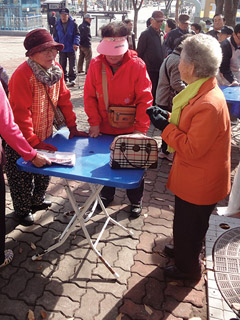 When lunch was ready, I would fall into line behind other volunteers, and take trays of food to our guests. I’ve waited upon elderly people before, but this crowd, especially the women, were really, really old. The word for “grandmother” in Korean is halmune, and it is used as something of an honorific; meaning,
When lunch was ready, I would fall into line behind other volunteers, and take trays of food to our guests. I’ve waited upon elderly people before, but this crowd, especially the women, were really, really old. The word for “grandmother” in Korean is halmune, and it is used as something of an honorific; meaning,
it’s completely polite to use it when greeting an old lady you’ve never met. (Try that with a woman in New York City — “Hey, Grandma!”
— and she’d probably kick you in the ass.) Anyway, the halmune in Busan were incredibly aged, their faces deeply lined and creased by their years.
I’d watch them from the window of the truck, as I helped Mr. Shon cook. They’d come hobbling into the little plaza where folding tables and chairs would soon be set up. Bent low over canes, their postures stooped with age, it appeared as if their torsos were nearly parallel to the ground. Moving slowly, they’d eventually find a place in the sun, where they’d sit, chatting and gossiping with their friends, while snacking on dried seaweed.
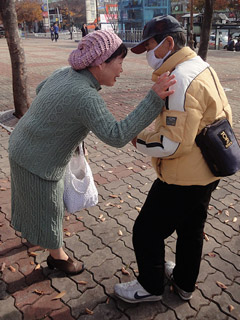 Shortly before we are to serve lunch, a woman wearing a celadon-colored sweater and skirt comes bounding into the plaza. She’s maybe fifty-years-old, which makes her a generation younger than these other women; she could be anyone’s daughter. With excessive energy and cheer, she skips about, screaming “Hallelujah!” over and over again, in a lusty, deep voice. She passes out hard candies, while she pats heads, squeezes arms, and pinches the cheeks of the halmune. All the while, she keeps repeating that same one word: “Hallelujah!”
Shortly before we are to serve lunch, a woman wearing a celadon-colored sweater and skirt comes bounding into the plaza. She’s maybe fifty-years-old, which makes her a generation younger than these other women; she could be anyone’s daughter. With excessive energy and cheer, she skips about, screaming “Hallelujah!” over and over again, in a lusty, deep voice. She passes out hard candies, while she pats heads, squeezes arms, and pinches the cheeks of the halmune. All the while, she keeps repeating that same one word: “Hallelujah!”
When we’d had breakfast together earlier that day, Mr. Shon mentioned quite in passing that he was a Christian, yet Busan Baffer is a non-religious organization, and there is no prayer said before lunch, or any religious proselytizing whatsoever.
Understanding little of what she says, I now see, to my considerable dismay, I’m about to be outfitted in a pink and white checked gingham smock.
Yet, here was this woman, perpetrating an act of guerilla evangelism. Now, she begins to belt out the song, “What A Friend We Have in Jesus!” She has a strong alto voice, and though the words are Korean, I recognize the melody. While she sings, the woman dances about, does jaunty little pirouettes, and sometimes comes to stop, only to wiggle her butt like a burlesque dancer.
“I think she must be crazy,” I say to Mr. Shon.
He smiled. “No. She is just a bit obsessed with her religion.”
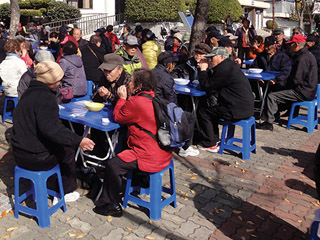 Other workers began to unload the folding tables — each of which can seat four guests — and plastic chairs. This creates bedlam. The old ladies who’ve been so calm are roused now into territorial skirmishes, trying
Other workers began to unload the folding tables — each of which can seat four guests — and plastic chairs. This creates bedlam. The old ladies who’ve been so calm are roused now into territorial skirmishes, trying
to lay claim to certain patches
of the plaza. Those spots under trees where the midday light is dappled, are considered most desirable and worth fighting for. It’s astonishing to see the squabbling, pushing, and sharp elbows tossed. Eventually, everyone finds a place, though, and the tables are set up in a neat rectangular grid, with space in between for volunteers
to move.
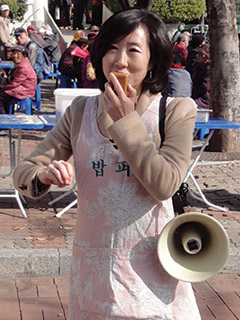 Before we servers can pick up a tray, we’re given a pep talk by a chic young woman who’s dressed in a beige cashmere coat. She looks like she is about to preside over a luncheon of the Busan Junior League, not a crowd of impoverished grannies. She speaks into a microphone that is attached to an amplification system that hangs from a strap over her shoulder, and is no bigger than a purse. Understanding little of what she says, I now see, to my considerable dismay, I’m about to be outfitted in a pink and white checked gingham smock. Not a midriff apron tied at the waist, mind you, but a full-frontal affair that had me resplendent in flouncy ruffles from kneecaps to shoulders. This horror was accessorized with a pouffy hat made from the same gingham fabric.
Before we servers can pick up a tray, we’re given a pep talk by a chic young woman who’s dressed in a beige cashmere coat. She looks like she is about to preside over a luncheon of the Busan Junior League, not a crowd of impoverished grannies. She speaks into a microphone that is attached to an amplification system that hangs from a strap over her shoulder, and is no bigger than a purse. Understanding little of what she says, I now see, to my considerable dismay, I’m about to be outfitted in a pink and white checked gingham smock. Not a midriff apron tied at the waist, mind you, but a full-frontal affair that had me resplendent in flouncy ruffles from kneecaps to shoulders. This horror was accessorized with a pouffy hat made from the same gingham fabric.
I wasn’t being singled out; all volunteers had to wear this cutesy-poo uniform. Still, the South Koreans were used to it, I told myself. For me, a foreigner, it was especially excruciating. O.K. Fine. Maybe I was being a little vain. But one didn’t have to be Narcissus to find this costume objectionable. I felt like an American Girl doll, or the proprietess of a pie shop in Tuscaloosa, Alabama. (“Y’all want some whipped cream with that?”)
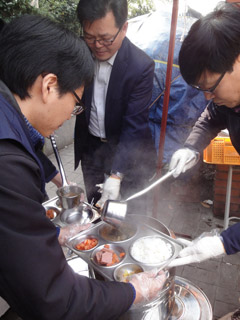 Portion control is exceedingly strict; each tray gets exactly the same amount of food. The soup has been deconstructed so it takes three people — one to place a blob of cabbage, another a few pork bones, and a third to
Portion control is exceedingly strict; each tray gets exactly the same amount of food. The soup has been deconstructed so it takes three people — one to place a blob of cabbage, another a few pork bones, and a third to
ladle broth over these first two items — to reassemble every serving. The trays are only complete, however, after they’ve been loaded down with a huge mound of rice, and kimchi.
Our hostess, the lady in the beige coat, now acted as a maitre’d, standing amidst the sea of folding tables, her arm in the air, waving gaily, as a signal for where we volunteers would find the next diners who needed a tray of food. It was all rush-rush, as we worked our way across a group of maybe 50 tables. By the time we got to the end, the diners in the first tables were already finished, and a new group of hungry diners was sitting down to take their place. There were only about ten of us waiters, so we had to hoof it. I tried to count the number of trays I brought out, but lost track after 25. We ending up serving over 350 people.
 Only belatedly, did I realize this dreaded hat and apron served some larger purpose, as the senior citizens we were serving got the hugest kick out of seeing us dressed this way. I’d come marching up to their side, lean down and, as we were carefully coached to do, I’d sing out, “Ma Shih Ke Du Say Yo!” to each seated guest as I placed their tray of food, which is the Korean way of saying “Bon Appetit!” They’d look up at me, then begin laughing and laughing until tears sprang from their eyes. It was painful, truly, to be in this costume, but when I saw how happy it made the halmune, it was (almost) worth it.
Only belatedly, did I realize this dreaded hat and apron served some larger purpose, as the senior citizens we were serving got the hugest kick out of seeing us dressed this way. I’d come marching up to their side, lean down and, as we were carefully coached to do, I’d sing out, “Ma Shih Ke Du Say Yo!” to each seated guest as I placed their tray of food, which is the Korean way of saying “Bon Appetit!” They’d look up at me, then begin laughing and laughing until tears sprang from their eyes. It was painful, truly, to be in this costume, but when I saw how happy it made the halmune, it was (almost) worth it.
While Thursday’s arrangement was a “pop up” picnic, with a clientele of mostly old women, on Friday, Busan Baffer served lunch inside a low canvas tent erected alongside a now-
abandoned train station in a neighborhood called Busanjin. Situated at the base of the Sujeong mountains, Busanjin is one of the poorest areas in Busan, and today’s guests are primarily homeless men. This crowd is much rougher than yesterday; these guys are dirty and disheveled.
Because Koreans don’t like to be alone, the profound isolation from other people is the hardest thing about being homeless.
“Hello, U.S.A.!” one man calls out to me. When I return his greeting, he stops to talk. Smoking is forbidden inside the tent, he explains, so he’ll have a quick cigarette outside while visiting with me.
“That’s really all I do all day. Smoke and drink. Drink and smoke!” The man laughs, with his mirth quickly devolving into a rumbling, phlegmy cough. His teeth are brown around their edges, stained by nicotine. This is Tae Ha, who is 54, but looks nearly a decade older, as living on the streets has aged him. To my surprise, he speaks perfect English.
Part of the national psychology of Koreans is they tend to cluster in groups, and to socialize in packs, Tae Ha tells me. Because Koreans don’t like to be alone, the profound isolation from other people is the hardest thing about being homeless. It’s also hard for men living on the street to make friends with each other; ultimately, they are competing for the same hand-outs, or space over a subway grating.
Tae Ha points to other men, milling about as they wait for lunch to be served. Becauses he comes to this tent to eat lunch nearly every day, he recognizes most of the other regular guests, and knows many facts about their lives. I begin to understand there is a pecking order of whose story is the saddest, or most pathetic. “See that guy? He’s an ex-Marine. Him? One of his legs is shorter than the other, and he can’t get around without those crutches. Oh, and that guy. He’s a bully. He tries to control everyone, and make them do what he wants.”
“Me?” he concludes. “I could care less about any of them.”
It’s hard to tell how much of this hard-boiled bravado is genuine.
Tae Ha says all he’s had to eat since lunch yesterday is half a chocolate bar, and a bottle of shoju. This last is a drink distilled from rice. It has a high alcohol content, which can range from 16-percent to a whopping 45-percent.
How can Tae Ha afford to buy shoju?
He appears insulted by my question. “I have a bank account!” he declares. “When I need money, I call someone in my family, and they put something into it. But I don’t spend much, as the only things I ever have to buy are shoju and cigarettes. So, fuck money!”
There’s a local saying that work in Busan is
characterized by one or more of the 3 “D’s”:
Dirty, Dangerous, and Difficult.
His father was a foreign diplomat, or so he claims. He grew up in Iran, came back to South Korea when he was in his twenties, and went to college for a couple years in Seoul, but never managed to finish his degree. Instead, Tae Ha got a job working as a silkscreen artist at a plastics manufacturer. Then, in the financial crisis of 1997, he was laid off, and couldn’t find another job. His lack of a bachelor’s degree is the single biggest problem he faces, as most employers will not even consider hiring someone unless they are a college graduate.
Another problem, though, is South Korea’s economy is overwhelmingly centered in Seoul, and most of the good jobs are only found there. There’s a local saying that work in Busan is characterized by one or more of the 3 “D’s”: Dirty, Dangerous, and Difficult.
“Unlike most of the guys you see here today, I can read and write in both Korean and English,” he said. “But I don’t tell any of them this. They’d think I was nuts.”
Again, it’s a little hard to believe everything Tae Ha says. Is it really possible that an educated, well-traveled son of a diplomat could have fallen so low? Tae Ha may be under-qualified for work, but he’s certainly overqualified to be homeless.
 Inside the tent, stereo speakers have sprung to life, and the loud sounds of K-Pop begins to blast out. The aggressive cheer of this music is at marked contrast to the shadowy chill inside the tent, where long rows of tables are set up, and several hundred men are waiting to be served lunch. I now notice Busan Baffer not only provides free lunches in this tent, but also the screening of the occasional movie. When I ask Tae Ha if he’s heard of the film that will be shown tonight, he tells me the title, translated from Korean, is “I Am King,” and it stars a handsome young actor named Joo Ji Hoon, who is a matinee idol in Korea. The movie tells the story of a prince during the Joseon dynasty who does not want to become king, so he hires a beggar to take his place.
Inside the tent, stereo speakers have sprung to life, and the loud sounds of K-Pop begins to blast out. The aggressive cheer of this music is at marked contrast to the shadowy chill inside the tent, where long rows of tables are set up, and several hundred men are waiting to be served lunch. I now notice Busan Baffer not only provides free lunches in this tent, but also the screening of the occasional movie. When I ask Tae Ha if he’s heard of the film that will be shown tonight, he tells me the title, translated from Korean, is “I Am King,” and it stars a handsome young actor named Joo Ji Hoon, who is a matinee idol in Korea. The movie tells the story of a prince during the Joseon dynasty who does not want to become king, so he hires a beggar to take his place.
Hearing this, I am dismayed. It seems a nearly perverse act of programming to subject a crowd of homeless men, today’s beggars, to such a plot.
I don’t have long to brood on this, though. Lunch is about to be served. Lining up are teams of volunteers from some of South Korea’s largest corporations. The majority of these volunteers are men, and they wear nylon vests over their business suits, that are emblazoned with the names of their companies: Hyundai, Daewoo, and Han Jeon, which is a major provider of electricity in South Korea. It seems odd, this “branding” of social service.
I am about to get in line to start bringing trays of food inside, but Mr. Shon grabs my elbow, so I stand beside him for a while as he serves soup.
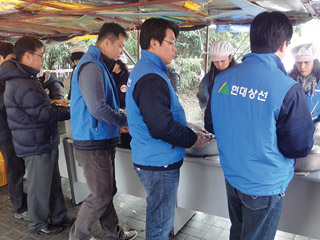 In what seems an uncharacteristic moment of pessimism, Mr. Shon complains about the difficulty he’s had in finding a permanent home for these lunches in the Busanjin neighborhood, other than this dark and drafty tent. His repeated requests to refurbish an abandoned building or unused floor of office space have been ignored. He notes that Busan is able to organize a massive fireworks display each year that is shot off from the city’s main bridge. This money could be better used, he feels, to benefit the truly needy in Busan.
In what seems an uncharacteristic moment of pessimism, Mr. Shon complains about the difficulty he’s had in finding a permanent home for these lunches in the Busanjin neighborhood, other than this dark and drafty tent. His repeated requests to refurbish an abandoned building or unused floor of office space have been ignored. He notes that Busan is able to organize a massive fireworks display each year that is shot off from the city’s main bridge. This money could be better used, he feels, to benefit the truly needy in Busan.
Most of South Korea’s elected officials are not really interested in social welfare, Mr. Shon believes. Politicians are much more keen to serve the rich — since it is the wealthy who donate to their electoral campaigns — than in helping the poor. Such corruption is indicative of what he says is the growth of class consciousness, and the very deliberate creation of an elite, or “upper crust” segment of society.
“The economic crisis in South Korea is growing. The rich are richer; the poor are poorer. The Korean government recognizes this, but does not have any policies in place to counteract it.”
With a pang of shame, I realize that all these charges leveled against South Korea, could be said about the United States of America, too.
I want to tell Mr. Shon this, though I’m not sure it will make him feel too much better. Before I have a chance to reply, however, he waves me back into the serving line. There’ll always be time to argue about politics. As for right now, men are hungry, and waiting to be fed.



